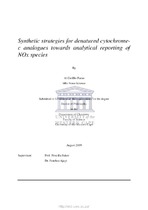| dc.description.abstract | Nitric oxide (NO) plays a key role as biological messenger in the biological system, however detection and quantification thereof has always posed significant problems. NOx is a principal constituent of air pollutants. There are seven oxides of nitrogen of which N2O, NO and NO2 are most important. NO is a free radical and reacts extremely fast with oxygen, peroxides and superoxides. It’s these reactions which are responsible for NO’s fleeting existence.
The specific detection and quantification of NO still remains challenging. Most techniques rely on the measurements of secondary nitrite and nitrate species. Electrochemical techniques using ultra micro-electrode systems presented the possibility of direct detection of NO, offering a range of favourable characteristics; good selectivity towards NO, good sensitivity, fast response, long-term stability and ease of handling.
Electrochemical detection of NO relies on the modification of electrode surfaces and exploiting the redox properties of NO. NO can either be oxidized or reduced electrochemically depending on the nature of the solution. Under cathodic current NO is reduced to nitrosyl, a highly unstable derivative of NO. These nitrosyls are subject to a serious of chemical reactions to eventually form nitrous oxide. Due to the interferences presented by the electrochemical reduction of NO, the electro oxidation of NO is therefore the methodology of choice for NO detection. The electrochemical oxidation of NO occurs at positive potentials around 800 mV vs. Ag/AgCl. However this potential range is not only favourable to NO oxidation but can lead to the oxidation of several other biological species. These interfering species are biologically present at concentrations higher than NO therefore selectivity is of the highest order when designing these electrode systems. Some nitric oxide sensors are limited in their sensitivity, stability and reproducibility.
Direct electron transfer between redox proteins and conductive membrane layers has been scrutinized for years in an attempt to reproduce the mechanistic charge transfer processes for sensor application. However, literature reports have presented many arguments on the complexities associated with depositing these enzymes on electrode surfaces for the purpose of reproducing direct electron transfer at metalloprotein centres.
The study sets out to design a material which could mimic the electrochemistry of denatured cytochrome-c. To achieve this it was imperative to design a polymer which could reproduce the electrochemistry of the ligands coordinated to the metal centre of the metalloprotein. A novel Schiff base was synthesized by cross-linking naphthalene to pyrrole to produce the monomer, N,N-bis((1H-pyrrol-2-yl)methylene)naphthalene-2,3-diamine). The monomer was electrodeposited on a screen print carbon electrode (SPCE) vs. Ag/AgCl and served as a supporting layer for denatured cytochrome-c. Cytochrome-c is classified as a metalloprotein. These metalloproteins possess metal centres which when denatured unfolds and allows access to the metal centre. Cytochrome-c was subjected to thermal denaturation which opened up the iron centre. The denatured metalloprotein was cross-linked to the ligand to reconstruct the heme centre environment. This was believed to facilitate the electrochemical activity of the system and allow for electrochemical analysis of these metalloproteins for sensor application. The redox behaviour of the sensors were modelled in phosphate buffer solution (PBS) with cyclic voltammetry. Electrochemical analysis reported the sensors to possess reversible electrochemistry with diffusion control characteristics. The sensor recorded a redox system in the negative potentials range. Following the establishment of the electrochemical profile of the sensor an attempt was made to produce a synthetic analogue of denatured cytochrome-c. Iron (II) was chelated to the monomer N,N-bis((1H-pyrrol-2-yl)methylene)naphthalene-2,3-diamine) to form an iron ligand complex. The complex was subjected to a series of characterization techniques which confirmed coordination to the metal centre. The iron ligand complex was electrodeposited on a SPCE over the potential window of -1 V and 1 V to model the electrochemical behaviour of the sensor. The material was found to be electroactive. Subsequent electrochemical analysis revealed the system to have electrochemical properties, analogous to that of the denatured cytochrome-c system. The sensor was applied in NO and NO2 studies and displayed an affinity towards NO. Based on extrapolated values it was postulated that the lower limit range for NO detection was in the range of 30 to 40 nM. The potentials recorded were lower than the reported oxidation potentials for nitric oxide. The sensor displayed stability and selectivity towards nitric oxide within a complex matrix. The complex matrix employed in this study was synthetic urine that was synthesised in the lab. The sensor displayed the capacity for linear range of NO detection with very low error margins. | en_US |

